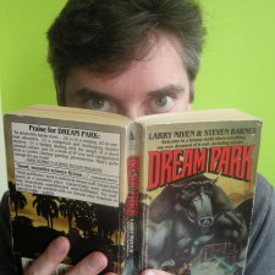 For the last year and a half now, I’ve been trying my hand in the Independent, self-publishing world online. It’s been a very interesting experiment, and I’ve learned a lot. But the one thing that really stands out to me is the air of aloofness I’ve seen.
For the last year and a half now, I’ve been trying my hand in the Independent, self-publishing world online. It’s been a very interesting experiment, and I’ve learned a lot. But the one thing that really stands out to me is the air of aloofness I’ve seen.
Traditional publishers, literary agents and even authors seem to look down their noses at the Indie movement. They equate Indie with Amateur, and poor quality. Of course, they are quick to jump on successful bandwagons like Hugh Howey, who make the jump from talented self-publisher to highly-paid traditional author.
But the traditional crowd aren’t the only ones to sneer. The Indies do it too. In particular, one of the most common things I read again and again is successful Indies declaring that you won’t sell books if your cover isn’t done by a professional. I find that to be a straw man argument. I mean, “professional” means you’re paid to do something. If the book is selling, and if the core of book sales is the cover, isn’t the 100% DIYer now, technically, a professional cover designer?
Moreover, just because a traditional publisher paid someone a lot of money to do the cover for one of their upcoming books, doesn’t make it good. Good Show Sir is a website that revels in awful covers on a daily basis. We’re talking spectacular crap that undoubtably only made sales due to shelf placement in book stores or perhaps Author Name-recognition.
But the Indies swear by professional covers. They also swear by professional proofreaders and editors and formatters. In fact, it seems a great many Indie authors basically don’t want you to do anything but write. I used to chalk this up to a lot of cover designers, proofreaders, editors and formatters lurking in the writing forums like sharks waiting to be fed. But now I’m not so sure.
Just today, as I write this, I started an innocent thread at the most-helpful writing website known to (this) man: Kboards. I simply asked who was 100% indie- meaning who does stuff entirely on their own. I even qualified my statement by explaining I simply don’t have the money to gamble on covers and dotting Is and crossing Ts.
Wow. What a backlash. Quite simply the unfriendliest response I’ve ever gotten over there. And it’s a cornucopia of friendly, knowledgeable people. Normally.
What does all this mean for you and me as Readers? Should we buy the hype from the traditional world that Bigger is Better? Should we only patronize Indies who act as project managers and put together books in the same manner as “Small Presses”?
Yes, I can see that a professional cover might have a better chance at luring in readers. A professional blurb, by someone skilled at writing them, might also work wonders. And, as a reader, I can only take so many typos- whether it’s a Big Six paperback, or a Kindle Indie work. But what really led me to my book purchase?
 Marketing.
Marketing.
It simply doesn’t matter how much money you as an Indie, or as a Traditional Publisher, pump into a book. If I don’t see it, I can’t buy it. And that’s where marketing comes into play.
In the old days, I’d journey into a bookstore and of course I’d see the prominently-displayed books first. If they didn’t appeal, I might go on a spine-reading quest, my head tilted to one side until I got a crick in my neck.
Today, it’s all online. I can pick genre’s by webpage, instead of aisle. I can look at covers with the flick of a finger or mouse, sitting comfortably in one place. But in the end, I’m only going to look so far. Eventually, I’ll tire of searching. I won’t likely look at three dozen pages of books to pick one out.
I can prove that marketing works. On months I do nothing with my own writing, I barely make any sales. On months I tweet, or maybe get a book review, or even pay for an ad, I sell a few dozen copies. That’s a huge jump in sales for me. And all with the same cover, the same DIY proofing and editing.
This saddens me, both as an author and as a reader. It saddens me because it means there are many, many works out there that I might truly love, but that I’ll never see, because the Indie Author who’s uploaded their work is like me and can’t afford “professional” polishing services. They’ve had to work as an artisan does, crafting their work all by their lonesome. They have to depend on luck to make their sales, hoping word of mouth will one day spread the word, or some advertising sugar daddy will take up their cause.
There’s no way around this, other than to suggest readers dig a little deeper when searching for gold. And we are all the poorer for it.











I think you overestimate the cost of putting a cover together. There are plenty of artists and freelance designers who can do this for you at a very affordable price.
It is true that you can sell a self-published non-fiction book with a basic cover. However that is because people would be reading for the author’s specialist knowledge. With fiction, trying to save on the cover might be a risk too far.
It comes down to the old publishing dictum that anyone can publish a book, the hard part is selling it. Scrimping on the cover is not going to get people excited about someone’s work.
The future of this business is with the Indie. Another way of looking at this is to take Advent:Publishers, Inc. as an example. They are the oldest “Indie” specialty publishing imprint in existence still owned and operated by the original founders (1955). When did this “Indie” become an established imprint? They certainly don’t consider cover art done by professionals a requirement. For decades the books they produce have been only titling on a colored background. Yet they remain a continued success and have been for over fifty years. So, is a cover done by a “pro” necessary in order to succeed? No.
It would seem that content is the driving force. Certainly Martin makes a telling point when he focuses his concern on the marketplace. He is spot on. How do contemporary Indies make a niche in the marketplace? How do they attract new readers?
But these issues are not only the concerns of the Indies, but also of the more established imprints. There is a sea-change going on, a shift away from the printed word to cyberspace. The answers to these questions concerns the entire industry, not just Indies.
Yes, it does help to have deep pockets. Quality proofreading and editing is always a signpost of better content. But a great cover often conceals vapid content.
I suspect that the more established sector is ardently watching the more experimental Indies, learning from them and applying any and all successes and inroads they make into answering the question of how to gain a greater market share.
As the Indies chip away proceeding toward an answer, the established imprints follow, while pretending to lead. And they continue tossing large sums of money all the while, which seems a sure way to go bankrupt.
Back in the day, after WWII, distribution was the lock on marketplace shares. Distribution was mostly Mob controlled. It was expensive, taking the lion’s share of the profits. Those imprints that established their own independent distribution network, like Bill Hamling (one-time Amazing editor) succeeded.
Today Indies are also constrained by groups like CreateSpace (which takes nearly half of the reasonable cost of a book) and Amazon (which takes nearly half of the remaining reasonable cost of a book). They are the new “distributors.”
What Indies need to do is join forces and create their own print to marketplace distribution network. A “Confederation of Indies” pooling their resources should be able to find a printer in this country (considering the state of the economy) who would be glad to get the work, and charge accordingly, cutting the exorbitant costs of businesses like CreateSpace in half. And as for Amazon (taking up to 33% on a sliding scale) it would seem more than reasonable that this same “Confederation” could find or even create their own website and shipping department that would charge a flat fee for all books (and pack them without damage–how many Indies have encountered this recurring problem…damaged books sent by the shipper?).
This would seem to be the next logical step in the evolution of the Indie, not only the DIY production of the book, but the DIY printing and shipping, cutting out all the middlemen and their stranglehold on them.
This solution would also provide a one-stop shop for Indies, where all members could display their works, going a long ways toward solving the advertising problem of small Indies.
Author’s Note: The choice of images for this article was made by Amazing’s Editor(s) not me. This was not meant to plug my work or say whether my own covers were good or bad.
Yes, and I chose to showcase one of your covers because I felt it appropriate, not as commentary
I can’t say I’ve had the same experience. My books are 98% DIY (the covers are built from ‘free for commercial alteration’ photos that I download). I’ve certainly had people suggest I get a professional to do the covers, but I’m pretty confident that that’s because the covers aren’t great. They’re not terrible, and they’re better than some professional covers I’ve seen, but they’re not stunning. It doesn’t bother me – as did you, I started self-publishing for enjoyment, and I’ve had fun learning about it. I know the mechanics of putting a cover together, but that’s not the kind of art I’m good at.What I’m better at is writing, and I’d rather concentrate my limited time on doing that well, than trying to learn to paint, etc.. I don’t look down my nose at people who can make great covers on their own. However, it’s not a skill I have a lot of, so I can see hiring a pro some day.
Suggesting readers just look past mediocre covers seems unrealistic. I’m a reader too, and sorting through the piles of dross for a gleam of gold is tedious. Anything that helps, including a snazzy cover, is welcome.